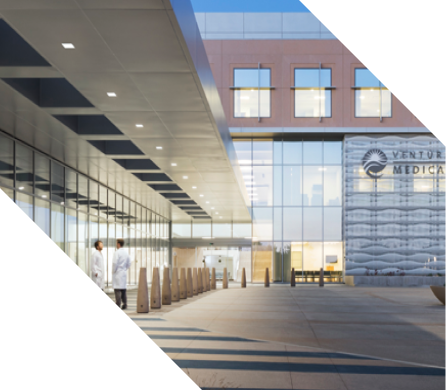When disaster strikes, be ready
Utilization optimization: how a hospital delivered non-stop care during one of California’s massive wildfires

The insight
A clearly defined disaster preparedness plan, combined with efficient inventory management and logistics, can keep a healthcare system running, no matter its size or the disaster. What comes out of that planning is the ability to provide uninterrupted care in the midst of a crisis. Our relationship with Ventura County Health Care Agency is a great example of how we moved beyond the role of a supply vendor to help this California system provide the best possible care.
As health systems prepare for the unknown, caregiver readiness along with operational efficiencies related to inventory management and utilization optimization are key to handling disaster scenarios. We work alongside facilities and their healthcare personnel to enact emergency plans and ensure the supplies and utilization resources are there where and when they need them.
Natural disasters put tremendous stress on supply chains and existing inventories. When working together to prepare for unexpected obstacles, the first questions we ask are, “What can we do to help our partners work more efficiently in times of crisis?” and “How can we help clinicians provide continuous care and spend less time worrying about whether the supplies they need will be there?” This case study underscores our commitment to Ventura County Health Care Agency during one of California’s largest wildfires. It showcases the importance of being able to flex our operations in emergency scenarios as challenging as the Thomas Fire. When the roads finally reopened, we were there to quickly re-stock the facility with medical supplies needed, operationally flexible to meet Ventura’s changing needs and, at every step of the way, proactively reach out to help.


- Ventura County Medical Center (VCMC) is part of Ventura County Health Care Agency, a fully-integrated, comprehensive system—hospitals, 30 outpatient clinics and specialty services—providing access to residents throughout
- VCMC is a 223-bed general acute care hospital and Level II Trauma Cente
As the main medical facility for Ventura County, Ventura County Medical Center (VCMC)—along with the county and supply partners—had to prepare and respond to the Thomas Fire (at the time, the largest wildfire in California history), so it could continue delivering essential medical and surgical services to the county’s residents.
- VCMC enacted emergency management plan with all internal and external team members
- Throughout the emergency, we ensured that VCMC and Santa Paula Hospital had the critical supplies needed
- The emergency plan guaranteed caregiver readiness and supplies on hand
- PAR levels of critical supplies were maintained, and VCMC never ran out of masks, despite heavy usage
- In addition, we had the resources to assist with temporary county shelters in conjunction with Ventura County Health Care Agency
As the designated Level II Trauma Center for Ventura County, VCMC provides access to health care to all residents, although special emphasis is placed on providing access to care for the underserved and those facing barriers to access.
The Ventura County Health Care Agency system also includes Santa Paula Hospital, an acute, 49 bed full-service community hospital providing care to Santa Clara Valley residents. Santa Paula Hospital offers a comprehensive list of inpatient and outpatient services and full-service departments for diagnostic procedure, treatment, aftercare and ongoing care.
Challenges
On December 4, 2017, the Thomas Fire began in southern California near Santa Paula in the foothills above Thomas Aquinas College. The Thomas Fire, lasting a little over a month, burned 281,893 acres, of which 181,333 were on Los Padres National Forest. More than 1,000 structures were lost in the fire before it was fully contained on January 12.
A disaster of this magnitude would put an enormous strain on the healthcare system at the forefront of the crisis. If supplies were unable to get through due to closed roads or other factors, then a crisis preparedness plan would have needed to be implemented and executed in advance.
Actions
VCMC deployed their emergency management plan and responded to the fire. And through the course of the wildfire, they continued delivering essential medical and surgical services to the county’s residents, meaning they were able to maintain an adequate amount of supplies on hand. Much of this was due to the following:
- A comprehensive Disaster Preparedness and Response Plan to respond to a wide range of disasters, including five specific scenarios that could take place. VCMC finalized plans for each scenario, along with Medline, to enact once a disaster struck.
- An inventory management system that can be used to redirect any portion of more than $1.8 billion of our inventory into a targeted geographic area. For the Ventura system in southern California, our distribution centers offer a logistical advantage in times of crisis.
- With an encroaching fire, we enacted our respiratory disaster plan, which included a formulary of critical products such as facemasks ready to be put on trucks bound for the hospital at a moment’s notice, making sure our fill rate was 100% on all the formulary supplies.
Solutions in advance
As the primary healthcare provider in Ventura County, VCMC has always been committed to serving the needs of their residents in time of crisis. To ensure they’re ready at a moment’s notice, they had developed a VCMC preparedness committee, consisting of several hospital leaders and department heads, including the emergency department since that is the focal point for most disasters—at least at the beginning. Because of our partnership with Ventura, we were able to play a critical role in the development of an emergency preparedness plan from the beginning. A key part of each emergency action plan is setting up an Incident Command Center at the outset of the emergency.
Together with VCMC’s Incident Command Center, which oversees logistics, operations, supplies and public information, Medline put a comprehensive Disaster Preparedness and Response Plan in place. This plan enables us to respond to a wide range of disasters, including specific scenarios that could take place at any of the facilities.
In addition, our inventory management system offers the highest service levels in the healthcare industry and gives us confidence that we will get the products we need when we need them. For our hospital system in southern California, our distribution centers in Tolleson, AZ; Aurora, CO; Salt Lake City, UT; and Temecula, CA; combined with the Rialto, CA and Tracy, CA distribution centers (two of Medline’s largest central stocking locations or “Hubs”), offer a logistical advantage in times of crisis. As situations occur, inventory is immediately re-directed to the areas with the most critical need.
Although the smoke and high number of emergency vehicles made the roads to and from the hospital almost impassable, Medline’s trucks got through somehow, and by mid-afternoon they delivered not only their own products but parcels from FedEx and other delivery companies.
Lessons learned
One of the hardest things about dealing with any natural disaster, especially a fire, is that no one knows what direction it will take. As with most disasters, the Thomas Fire was unpredictable. The key to maintaining non-stop, high quality care during a crisis depends on these key areas:
Planning: preparation, drills and simulations conducted with staff, key suppliers and community partners over the last many months allowed the system to perform under the most stressful of circumstances. This included organizing, make quick decisions, along with coordinating and implementing the plans in place.
Communication: the morning after the fire broke out—facing critical supply shortages, especially facemasks—the CEO of the system personally called his Medline Representative to order more masks, air purifiers and other critical supplies. And although the smoke and high number of emergency vehicles made the roads to and from the hospital almost impassable, Medline’s trucks got through. By mid-afternoon, we had delivered not only our own products but parcels from FedEx and other delivery companies.
Prioritizing care: given that during an emergency, hospitals frequently operate on backup generators, it’s important to prioritize emergency care and ensure your most vulnerable patients are stable. VCMC decided to suspend elective surgeries until the end of the fires in order to ensure those key areas had sufficient resources.
In the aftermath of the fires, VCMC worked with community partners, agencies and suppliers to conduct a debrief and identify opportunities to improve their disaster readiness in the future:
- Enhancing internal communications through current and accurate records
- Improving night staff training by increasing training beyond the day shift
- Identifying multiple areas to manage disaster, instead of just one
While the hope is that these types of disasters are few and far between in a hospital system or community, history has shown that unforeseen events happen. The efficiencies and readiness programs that result out of transparent planning with our customers make it possible for everyone to be prepared—when a disaster hits, no matter what it is—even better than before.
How can we help your business run better?
Contact us to learn more

